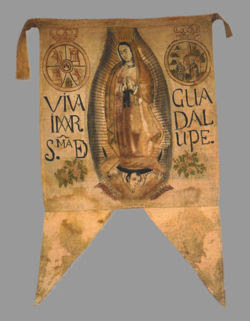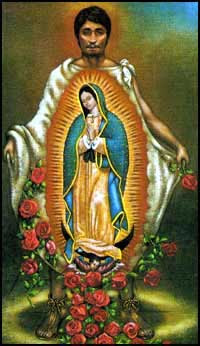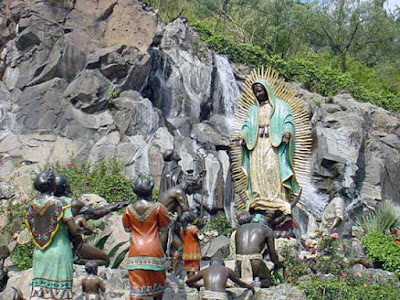State of the Union? How About the State of Children's Publishing?...
I hope you all got a change to watch history in the making today. Alas, I was at a meeting during the inauguration, but I'm planning to watch it later in the day with Murray (who will have his Air Force One made of Legos in tow).
In between inauguration TV coverage, online news and Twitter updates, you can read Harold Underdown's rundown of what's happened in children's publishing over the last few months as well as his take on how the current recession will affect those working in the children's book industry.
Viewing: Blog Posts Tagged with: Virgen de Guadalupe, Most Recent at Top [Help]
Results 1 - 6 of 6
Blog: Alice's CWIM blog (Login to Add to MyJacketFlap)
JacketFlap tags: Harold Underdown, The Purple Crayon, recession, Add a tag
Blog: What's New (Login to Add to MyJacketFlap)
JacketFlap tags: Book Bites for Kids, BlogTalkRadio, Margot Finke, Guardian Angel Publishing, Suzanne Lieurance, Harold Underdown, The Purple Crayon, The National Writing Center for Children, Add a tag
Blog: AmoxCalli (Login to Add to MyJacketFlap)
JacketFlap tags: Tonantzin, Virgen de Guadalupe, Tonantzin, Poetry Friday, Virgen de Guadalupe, Add a tag
On December 12th, at 2a.m. I was out at Placita Olvera (Olvera Street) dancing barefoot on the cold ground along with many, many others to pay homage to the Virgen de Guadalupe. Before I left, I wrote up a post about her and how much she means to me, my family and to the Mexican people. See the December 11th post for more about La Virgen Morena.
There is poetry to her as well as songs written in her honor. I thought I'd include some here along with the words to Las Manañitas - the traditional birthday song that we sing to her on her feast day.
Las Mañanitas is a traditional Mexican song that is sung on birthdays and other important holidays. It is often sung as an early morning serenade to wake up a loved one. At birthday parties it is sung before the cake is cut.
Las Mañanitas Lyrics:
Estas son las mañanitas
que cantaba el rey David
a las muchachas bonitas
te las cantamos aquí
Si el sereno de la esquina
me quisiera hacer favor
de apagar su linternita
mientras que pasa mi amor
Despierta mi bien despierta
mira que ya amaneció
ya los pajarillos cantan
la luna ya se metió
Ahora sí señor sereno
le agradezco su favor
encienda su linternita
que ya ha pasado mi amor
Amapolita adorada
de los llanos de Tepic
si no estás enamorada
enamórate de mí
Despierta mi bien despierta
mira que ya amaneció
ya los pajarillos cantan
la luna ya se metió
Here's just about the whole of Mexico singing it to her in the Basilica
and check this out!
The round up is here at The Miss Rumphius Effect. Thanks for hosting Tricia!
Blog: AmoxCalli (Login to Add to MyJacketFlap)
JacketFlap tags: photography, Virgen de Guadalupe, Add a tag
What a great interpretation!
http://phprblog.blogspot.com/2007/12/today-is-day-of-virgen-de-guadalupe.html
Blog: AmoxCalli (Login to Add to MyJacketFlap)
JacketFlap tags: Tonantzin, Virgen de Guadalupe, paying homage, Tepeyac, holy days, tradition, mexico, Virgen de Guadalupe, Tonantzin, paying homage, Tepeyac, holy days, Add a tag
In Mexico, I think nothing is more honored and adored than the Virgen de Guadalupe or, as I know her, Tonantzin. Her image is everywhere. Statues, candles, blankets, sarapes, scarves, murals, roadside shrines - her peaceful and radiant countenance blesses you. She lives in homes, tattoos, in the marketplace, in song, everywhere, she touches everything. Even one of the most popular singers in Mexico wrote a song for her! In fact, singers of all types - rock bands, mariachis, the
pop stars, the rancheros, EVERYONE loves the Virgencita Morena, the Goddess of the Americas.
She was the image on the banners and flags of Father Manuel Hidalgo and his followers in the Mexican Revolution. She is entrenched so deeply into our culture and ideology that she’s like an old and very beloved friend. We call her little mother. She’s our collective mother, the mother of a conquered but not defeated nation, the mother who fights for us, protects us and loves us no matter who or what we are and become. We live and breathe Guadalupe. In every family, someone, boy or girl is named Guadalupe and carries that name with pride. 
The Catholic Church has it's story of the Virgen de Guadalupe and Juan Diego, we indigenous people have another. Somehow, like so much in Mexico the two things blended and we have Catholic dogma mixed with indigenous belief. Tonantzin wouldn't be erased and she lives stronger than ever in our hearts and minds.
Every year on her day, December 12th - thousands of people gather at her shrine on Tepeyac to give her honor, to pay homage, to dance prayers for her, to sing Las Manañitas to her and to show their devotion. Indigenous people from all over Mexico leave their villages and walk or crawl up to the sierra de Tepeyac in an ancient pilgrimage. The actual holy ground is a little hill behind the Basilica. This hill was sacred to Tonantzin and consecrated to Her by the indigenous people of Mexico long before the conquest. The pilgrimage was happening in pre-Columbian times as well.
As far back as I can remember my life was dominated by the Guadalupe. In the sala (living room) my grandmother Lupe’s house (her name was Maria Guadalupe) in the place of honor on the wall was a huge, framed print of the Virgen de Guadalupe standing on the hill of Tepeyac with Juan Diego kneeling at her feet, tilma open and filled with roses. It was a beautiful print with a soft washed from age look to it. You could clearly see the nopales (cacti) that were growing on the hillside. Every day my grandmother would put fresh flowers in front of that print. “Flores para la virgen”, she would tell me, “Flowers for the Virgen”. I learned to cut fresh roses and other flowers from the garden for vases throughout the house, keeping only the best and showiest to put in front of the print. Just like my grandmother, I’d say a little prayer to her as I left her her flowers. She was as real to me as my sisters were and I talked to her far more freely. La Lupita was my confidant, my protector, my dear little mother.
At church, my grandmother was a member of a society called Las Guadalupanas and they were devotees of her. Every morning, my grandmother Lupe would don her lacy mantilla and head off for mass where she’d pray to the Virgen de Guadalupe. See, she’s everywhere and in everything.
In Aztec culture, Guadalupe was Tonantzin, the mother of all, Mother Earth, The Goddess of Sustenance, Honored Grandmother, Snake, Aztec Goddess of the Earth. She brought the corn, Mother of the Corn. Even then She was All and Everything. She represented mothers, fertility, the moon, the sacred number 7. In fact, she was sometimes known as 7 Serpent. She was always there and she was always our little mother.
Corn is sacred to Tonantzin. The flowers we know as poinsettias were called Cuetlaxochitl were also very sacred to her and they grew on Tepeyac in wintertime as tall as ten feet high. Tunas (cactus fruit or prickly pear) are also especially sacred to Tonantzin growing as they do on the cacti that grows on her sacred and holy ground. Filled with seeds inside and a rich, juicy red fruit, the tunas represent both fertility and the womb, the blood of women and the sweetness of life. Tomatoes are another sacred fruit to Her. On my altar, I often put flor de noche Buena (another word for poinsettias meaning flower of the good night), tunas, chiles, cacao beans and tomatoes. The colors red, white and green, the colors of the Mexican flag are sacred to Her as well.
Early tomorrow morning, the morning of the 12th at 2a.m. at the Placita Olvera (Olvera Street) in Los Angeles, mariachis, devotees of the Virgen de Guadalupe, Aztec dancers, folklorico dancers, deer dancers, musicians, priests, nuns, and many more will start paying homage to Her. We will sing Las Mananitas, the traditional birthday song, we will pray and dance. Aztec dancers will dance at Catholic masses everywhere and they will do the prayer dance Tonantzin first. They will dance various variations of Tonantzin and give Her honor. In Mexico, on a much larger scale, celebrities, the elite, the politicians, Zapatistas, narcotrafficantes, men, women and children will all pay homage to our beloved Virgen de Guadalupe. We will give thanks to her for all we’ve received from her merciful hands, we will pray for the sick, the prisoners, the homeless, the helpless and we know that She is mercy, kindness, acceptance and love. She commands a tremendous devotion from the people that love her just by being Guadalupe. I believe she has given me much – my life, my children, my grandchildren, the food I eat. She is the goddess of the harvest, she represents the mother in me and in all women. She simply is and so I say Tlaxocamatl Tonantzin, thank you virgen de Guadalupe for all you have given. Tlaxocamatl Tonantzin. Ometeotl.
From the City of the Queen of the Angels, desde la ciudad de Nuestra Reina de los Angeles,
Atonatiuh Eloxochitl
Mar y Sol Datura Flower
otherwise know as
Gina MarySol Ruiz
Who is on her way to dance for the Virgen de Guadalupe and one for her Grandmother Lupe too.
Blog: La Bloga (Login to Add to MyJacketFlap)
JacketFlap tags: spirituality, poetry, community building, goddess, women of color, women's studies, Teatro Luna, Virgen de Guadlupe, Virgen de Guadalupe, community theater, Martin Espada, Add a tag

Marion Woodman is a Jungian analyst—and is one of the most inspiring voices in the global movement for peace. Here she joins forces with Elinor Dickson, Director of Psychological Services at St. Michael’s Hospital, Toronto to produce an informed and penetrating investigation of a source of spiritual and creative power, not popular in Western circles. In Dancing in the Flames, they point to a constellation of archetypal ideas which they hope will be a source to inspire and inform: the mythical complex of the Dark Goddess. Their book operates on two levels, as a guide for individual transformation and ultimately transforming society.
The core of the book is a cluster of chapters using psychoanalytic material that draws on the mythology of the Dark Goddess. Mind you, the frame of reference is European, but Woodman does attempt to bring in a non-Western perspective, honoring as best she can the thousand years of Hindi veneration to Kali, the root source for this archetype.
At a broad-brush level, this initially involved the matriarchal phase, a belief in a living world where everything in nature held spirit-life flowing from source, the Great Mother. This was followed by the emergence of a separate. individual 'self', then the formation patriarchal and hierarchical power structures.
Throughout the early part of this history, the archetype of this Goddess progressively is split off more and more from that of the Great Mother, emerging as a her polar opposite---killer, and scourge. In reality, it's the cleansing aspect of the Good/Bountiful/Great Mother. The split of the Great Mother vs. Dark Mother mirrors that schism between matriarchy and patriarchy, the body and the spirit.
The authors make the case that in the period that followed, both the Great Mother and the Goddess are repressed, and driven into the "murky depths of our unconscious." Yet the culture of the Goddess lives on, underground, in succeeding centuries. It eventually finds expression, despite repression, in the form of the Black Virgin from the twelfth century onwards. And I would argue, our own veneration of La Virgen, of Tonatzin, who survived colonization, a remains a vital life force in the Chicano/Mejicano soul and psyche.
The authors make an impassioned case that society as a whole must reclaim the Dark Goddess. To underscore, they turn to personal analytic material, allowing the reader to make their own contact with the goddess archetype. The mythological aspects of Virgin, Mother and Crone, making up the European triple goddess, are followed through their appearance in the therapies of both men and women, these images used as tools in the process of personal evolution. In my experience of Eurocentric, new-age feminism, its subtle racism links creativity/goodness with the idea of light and so I found it powerful and liberating to be reminded of the imagery of the holy darkness, its power to cleanse, nourish and renew.
This idea of darkness, again, is no stranger to indigenous ideas of the Mother--She Who Is. I have a personal source of connection to the Santeria/Yoruba deity of Oya Yansa. Oya is also also Dark Goddess, keeper of the whirlwind, sweeping clean all that is decayed, corrupt. It was important for me to reframe my own ideas of Mother, particularly in contrast to the long-suffering Virgin of my youth. This book was a thought-provoking resource, stirring up a fleshy, full-bodied, powerful female deity, one with deep hunger, deep ability to consume, transmute and transform.
The authors give a picture of integration inspired by the qualities of the Dark Goddess, a process in which fear of death, fear of nature, and fear of our own femininity (whether we are men or women) are reconciled in the dark. They stress the dangers of yearning for a world of "pure" spirit and "light," a state where in our yearning for perfection, we confuse a certain kind of "perfection" with wholeness.
I would further challenge the notion of light equaling perfection---light without the regenerative power of darkness is half of what is and only half. And under the harshness of unending, unshrinking light, all fades and withers away, spent beyond resources, starving for rest, for the dream world, for losing oneself and finding the body made anew.
One of the most interesting parts in the book subdivides the process according to the traditional chakra system, while still basing the account firmly on the actual material of analysis. From this viewpoint, integration is seen as a process of “building the subtle body,” of embodying spirit in a complete and integrated way.
The key step in this process, for the individual, involves the recognition of our own autonomy, the acceptance of ourselves, and the finding of our own voice. For this to happen, "it takes great resolve to enter the darkness of our own chaos, to give up the familiar path and begin to trust in our own experience. The recognition and unconditional love of oneself is never a selfish journey."
It's a journey of seeking awareness, increasing confluence between those things we normally separate as "physical" and "spiritual." At the end, the book returns to the societal level, where the authors’ believe the protests of the Sixties "were the seeds, at a culturally recognized level, of a movement based on hope for a more meaningful existence.... What began as a protest has become a challenge, a challenge that will involve not only technology, but a new understanding of human mythology."
Depending on how we choose to phrase it, either ideas of ' science' must be revamped to include experiencing this relatively unused 'female' approach, or needs to be blended into a larger view that gives equal status to this view. The authors’ account at the end gives us a start -- some tools that may enable us to do this. They give us immense hope, and also a profound challenge. This new vision is not one that we can dream up intellectually: it can be reached only by transformation, only if we "throw ourselves into the flames and dance in the refining fire..."
Our traditional ideas of 'science' stresses the intellect, the rational—in archetypal terms, a 'masculine' construct. It operates with ideas of impersonal, 'objective' discovery and 'absolute' truth. While it's an important way of knowing, it has limits as a basis for a new world view. There are deep questions that emerge. How do we construct gender and identity? How are those concepts linked to to behaviors like violence and passivity? How can we integrate complicated, contradictory ideas of male/female that include ‘dark’ and healing forces in both?
This book kept me up at night. It was another piece of encouragement to let go, to delve deep, and look at what's revealed without flinching. I'm always on the lookout for things that will strengthen me, as well as shake me up. The themes of violence, sexualized violence in particular, are shot through the fabric of this American life, and to ignore them is one darkness I find unacceptable. Dancing in the Flames provides a kind of comfort, as well as a challenge.
ISBN-10: 1570623139
ISBN-13: 978-1570623134

| |||||||||






I have been reading your blog for a week or so now after discovering your work through CWIM. Thank you for the link on this particular post. It was very insightful as I am currently in the process of preparing my first book to be sent out to publishers.
Hi.. How are you know my friend? Its me your classmate christian.. Remember? I see your blog it so beautiful and nice. Try also my blog.
http://movieswatcher0113.blogspot.com
http://charlestechno.blogspot.com
http://desktopwallpapers101.blogspot.com
http://wonderdestination.blogspot.com
I Miss You :)
Oh, I cannot wait to hear your thoughts on the inauguration!!! My favorites? Yo-Yo Ma, Obama's speach - which was heartfelt, humble, somber - yes - but appropriately and respectfully so... Notice Arethra's crazy-bow hat... and the little ones taking photos of Dad.
: )
I am on my way over......
I made my kindergartner's watch the swearing in, and they were all mad...
I said, "Some day when you have children of your own you will THANK ME.."
And they said,"EWWWWWWWWW"
yeah.